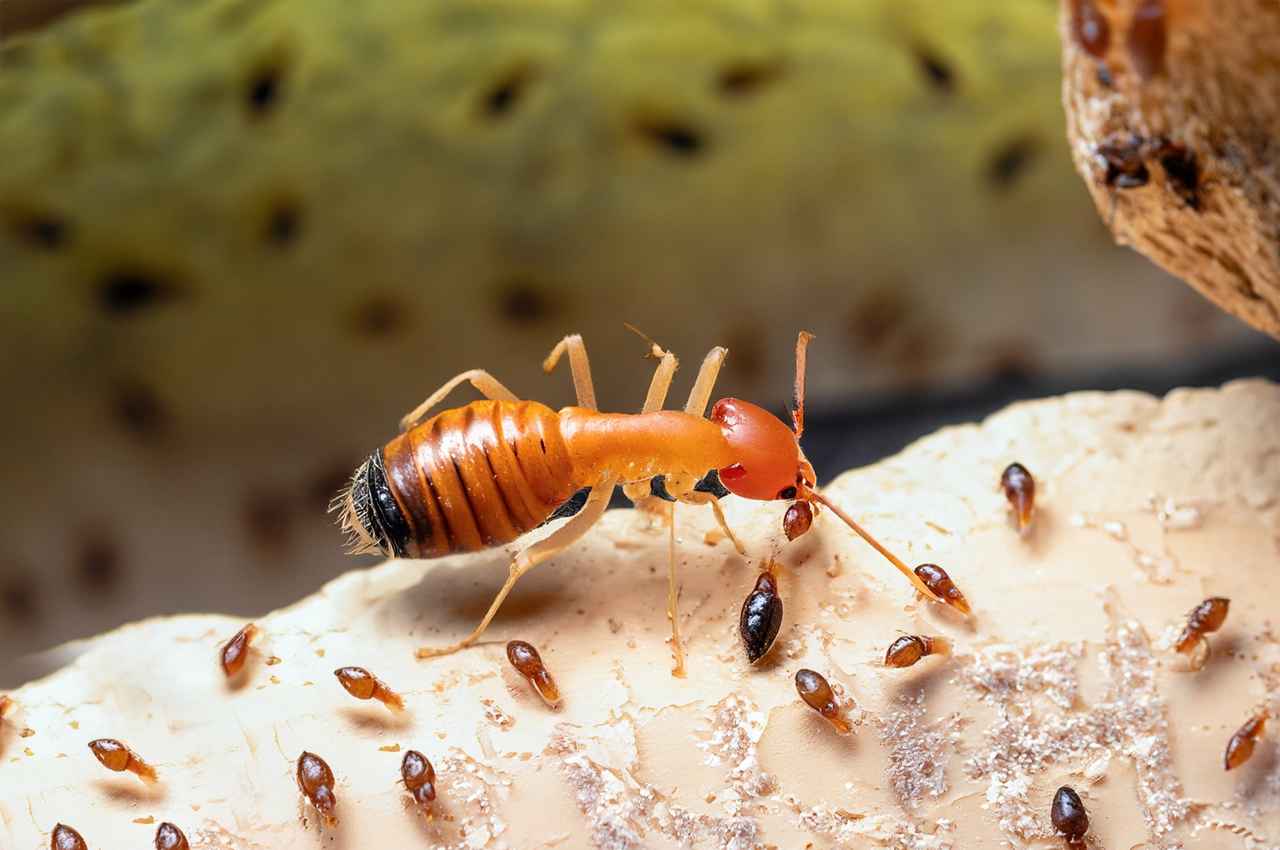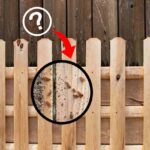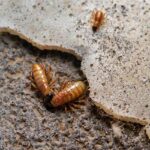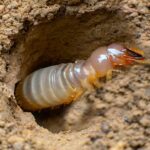A Deep Dive into How Termite Become Queen. Termites have a sophisticated caste system. The job of the termite queen is one of the most interesting, but how exactly does a common termite develop into one of these prolific egg-laying matriarchs? We’ll look at the fascinating transformation of termites into queens in this post.
How Termite Become Queen?
Termites change dramatically as they progress toward becoming queens. When the colony reaches a particular size and food availability, winged reproductives known as alates, instead of queens, are first created. The male and female alates lose their wings and mate after taking flight to locate a mate. The female then takes the position of queen in the new colony and continues to produce eggs for the duration of her life, which may last up to 20 years. Even though it is uncommon, a worker termite may turn into a queen in the event that the existing queen dies or is unable to lay eggs due to the lack of her pheromones. The termite colony’s existence depends on the queen’s crucial function in egg generation and pheromone regulation.
| Step | Description |
|---|---|
| Nuptial flight | Alates, winged reproductive termites, leave their parent colony to mate. This flight generally occurs at night, when predators are scarce. |
| Mating | After mating, alates land and lose their wings. The male and female will mate and the female will become colony queen. |
| Egg laying | The queen termite lays eggs and raises young termites. She will lay eggs for 20 years or more. |
| Colony development | Termites emerge from eggs and become workers, soldiers, and reproductives. The colony will increase as termites are created. |
Beginnings of a Queen
The queen’s journey starts as an alate, a unique, wingless reproductive termite. During swarming seasons, which are brought on by environmental variables including temperature and moisture, alates emerge from adult nests. They are necessary for colony expansion.
The Nuptial Flight
When alates emerge, they fly on “nuptial flights.” Male and female alates hook up and mate mid-flight on these frantic journeys. Then, when they are ready to build a new nest, their wings fall off.
Physical Transformation
One of the mated females experiences a dramatic metamorphosis, developing an expanded abdomen as she becomes the queen. Hormonal changes preparing her for reproduction are the cause of this extraordinary transformation.
Taking on the Queen’s Role
The queen’s main responsibility in the new colony is to consistently produce hundreds of eggs each day. The caste system is completed when these eggs hatch into nymphs that develop into workers, soldiers, and potential reproductives.
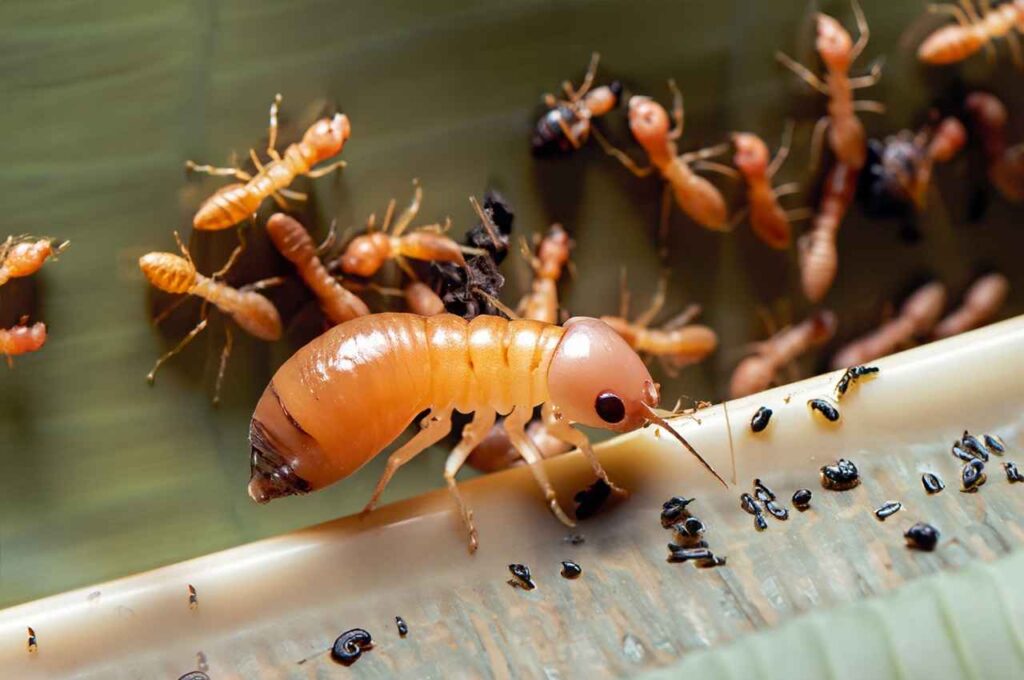
Remarkable Longevity
Termite queens may live anywhere from a few years to many decades, depending on the species. Because of their extended lifespan, they may have many progeny, which promotes colony expansion.
The Importance of Queen
Without the queen’s ability to reproduce, the colony would die. She is the colony’s beating heart. For her vital function in termite reproduction, she is fiercely guarded and adored.
Key insights into the termite queen’s crucial reproductive role may be gained by comprehending her intriguing transformation. Understanding their intricate biochemistry can help you control these devastating silent destroyers.
Termite Queen Influence on Colony Size
| Number of Queens in a Colony | Impact on Colony Size |
|---|---|
| Single Queen | Typical social organization with one dominant egg-layer. |
| Multiple Queens | More queens may lead to increased reproduction and larger colonies. |
Termite Queen Lifespan by Species
| Species | Average Queen Lifespan |
|---|---|
| Subterranean Termites | Several years to a decade or more. |
| Drywood Termites | Several years to a decade. |
| Dampwood Termites | Several years to several decades. |
Factors that can affect the number of termite queens in a colony
| Factor | Description |
|---|---|
| Species of termite | Some termite species have more queens. |
| Size of the colony | Multiple queens are more common in larger colonies. |
| Availability of food | Multiple queens are more frequent in colonies with ample of food. |
| Environmental conditions | Conditions like dryness might increase termite queens in a colony. |
Termite Reproductive Output by Species
| Species | Average Daily Egg Production |
|---|---|
| Eastern Subterranean Termites | 1,000 - 2,000 eggs per day. |
| Formosan Termites | 5,000 - 10,000 eggs per day. |
| Asian Subterranean Termites | Over 30,000 eggs per day. |
Frequently Asked Questions
What is the usual age at which termites become reproductively mature?
After finishing their growth from nymph to adult, most termite species reach reproductive maturity, which typically occurs between 1-3 years of age. Once termites reach this stage, they may reproduce the colony by mating and changing into alates.
What environmental factors cause termites to fly in swarms in search of mates?
Alates will often leave their nest and swarm in search of mates in response to important conditions including temperature, humidity, rainfall, and variations in the length of the day. Mating flights often occur in warm weather after spring rains because the environment is favorable for the development of new colonies.
How does the new termite queen's body physically transform after mating?
Her hugely expanded abdomen, which almost doubles in size to that of a laborer, is the most striking modification. Her ovaries and fatty body both experience this fast development in order to sustain her strong egg production. She has a bulging belly full of eggs to lay.
How many eggs does a termite queen typically lay each day?
Depending on the species, queens may lay anywhere between 1,000 and over 30,000 eggs every day. This incredible output is essential for filling the nest.
How long on average do termite queens live?
Termite queen lifetime varies by species and may last anywhere from a few years to many decades. According to one research, a Formosan termite queen produced hundreds of eggs each day for more than 12 years! Their longevity is essential for colony expansion.
Why is having a reproductive queen so essential for the colony's survival?
The queen, who is the only egg-laying female, continuously produces young termites, maintaining workforce numbers and allowing for nest development. She would ultimately stop producing young, and the colony would finally cease to exist without any new members. She is really necessary.
Why are queen termites huge?
Termite queens are huge because they are crucial to the colony. Their huge bodies hold millions of egg-producing ovaries. A queen may lay 30,000 eggs each day and 200 million in her decade-plus lifetime! The queen’s huge size allows her to produce infinite brood, which is necessary to populate and sustain the colony. Her size allows her to store adequate resources for her lengthy existence as the nest’s reproductive heart. The queen’s bulk allows her to release key pheromones that govern other termites.
How many termite queens?
The number of termite queens varies by species. Formosan termites, for example, only have a single queen in the colony. But eastern subterranean termites are known to have multiple queens within their nest. Since the queen is the sole fertile termite capable of laying eggs, her presence is vital. Her eggs develop into the sterile worker termites that maintain the colony. Colonies with more queens tend to be larger and more prolific due to higher egg production. With queens living so long, these multi-queen colonies can survive many years. But when the final queen dies, total colony collapse becomes inevitable without her reproductive powers.
Can Termite Queens Move Around?
Termite queens are quite stationary, only migrating when the colony swarms to reproduce. When the existing nest grows overcrowded, the queen – as the largest and only fertile termite – participates in the swarming event, her sole journey outside the nest. She departs with some workers to establish another colony elsewhere. The queen remains mobile until they find a suitable location to settle. She then begins laying eggs while workers build the new nest. For the rest of her long life, the queen stays fixed in one spot, continuing to populate the colony. Her one exception is the nuptial swarming flight essential for propagating the species.
- How do termite mounds help regulate temperature? - 7 January 2024
- 10 Effective Termite Control Methods That Actually Work - 4 January 2024
- How Long Does It Take for a Termite Mound to Form? - 21 December 2023
